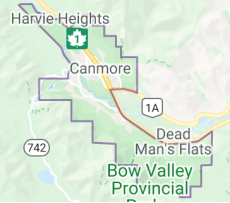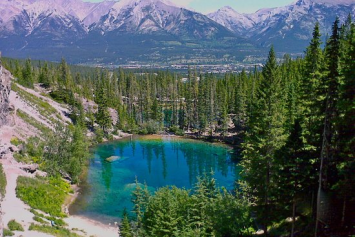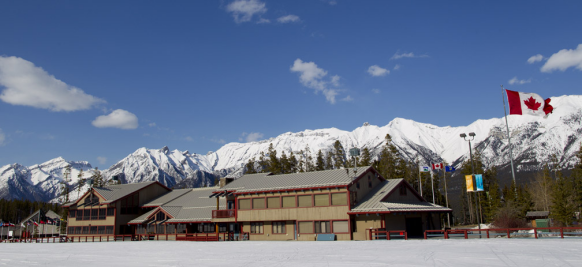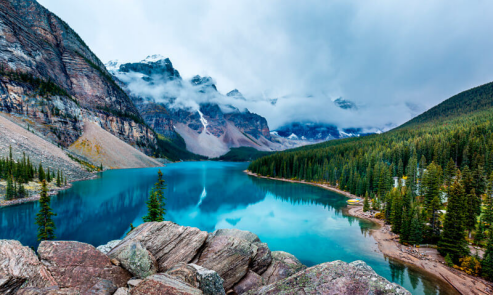Canmore, Alberta 作者: 来源: 发布时间:2021-12-06
I.Population and Area
-Area
Land: 69.43 km2 (26.81 sq mi)
-Population (2016)
-Total: 13,992
-Density: 201.5/km2 (522/sq mi)

II.Natural Geography (environment and resources)
-Canmore is a town in Alberta, Canada, located approximately 81 kilometres (50 mi) west of Calgary near the southeast boundary of Banff National Park. It is located in the Bow Valley within Alberta's Rocky Mountains. The town shares a border with Kananaskis Country to the west and south and the Municipal District of Bighorn No. 8 to the north and east. With a population of 12,288 in 2011, Canmore is the ninth-largest town in Alberta.

-Concerns over Canmore's urban growth adjacent to provincial and national parkland has led to many efforts to place a limit on future development. The town is expected to reach its maximum "build out" following the completion of the SilverTip and Three Sisters Mountain Village developments sometime around 2015–2020.
-Bisected by the Trans-Canada Highway, located on the Canadian Pacific Railway and run through by the Bow River, Canmore is ideally situated on a number of major transportation routes, which has influenced its tourism-based economy and historical mining industry.
-Much of the Canmore area has been designated a wildlife corridor. This corridor allows animals such as bears, cougars, wolves, and elk to move between habitat patches, where they can find food, escape predators, breed, give birth, and establish territories.
-Despite its modest population and environmentally friendly image, Canmore is highly sprawled and segmented (due to wildlife corridors, highways, the railway, and the Bow River) and takes over one and a half hours to traverse by foot. The pedestrian-friendly town centre surrounds 8th Street, or "Main Street" (as it is known colloquially), which was originally a residential road with some of the oldest architecture in the town; now, however, it is lined with small shops, restaurants, and galleries. Much of the recent development is taking place in Three Sisters Mountain Village, SilverTip Resort, and around the town centre.
III.ECONOMY
-Average Hourly Rate in Canmore, Alberta: C$19.91

-Website: https://www.payscale.com/research/CA/Location=Canmore-Alberta/Salary
IV.Industrial Characteristics
-The Town of Canmore originally depended on the coal mines. In the 1980s, the Olympics revived the economy and set the grounds for a high-end bedroom and get-away community which would depend on construction and tourism income.
V.Attractions
1.Grassi Lakes

-The Upper and Lower Grassi Lakes lie at an elevation of about 1,525 m (5,003 ft) in the southern Canadian Rockies overlooking the town of Canmore, Alberta. They receive their water from the Spray Lakes Reservoir on the Spray River. The land is part of the Canmore Nordic Centre Provincial Park, which is part of the Kananaskis Country park system.
-The lakes are named after Lawrence Grassi (1890–1980), an Italian who emigrated to Canada in 1912. After working for the Canadian Pacific Railway for several years, he began work as a miner in the Canmore coal mines in 1916. Grassi went on to become a well-respected climbing guide and built many trails in the area, including the one to the Grassi Lakes that bear his name.
-The small, emerald-colored Grassi Lakes are a popular destination for hikers and rock climbers. They lie at the foot of grey cliffs that are about 75 m (246 ft) high. The cliffs are part of the Cairn Formation, a fossil reef that formed during the Late Devonian period. The primary reef-forming organisms were stromatoporoids, a long-extinct type of bulbous sponge. The cliff is a favorite of rock climbers who use the pockets left by the sponges as hand- and foot-holds.
-Rock paintings that are more than 1,000 years old can be found near the top of the canyon beyond the lakes. They are believed to have been painted by Kootenai ancestors.
-TEL: 403-762-1550
-Website: https://albertaparks.ca/parks/kananaskis/kananaskis-country/advisories-public-safety/trail-reports/canmore-and-area/grassi-lakes-interpretive/?utm_source=TravelAlberta-ATIS&utm_medium=TravelAlberta&utm_campaign=ATIS+-+Alberta+Tourism+Information+Service&utm_content=Listing%2f1495%2fen-CA
2. Canmore Nordic Centre

-The Canmore Nordic Centre was originally constructed for the 1988 Winter Olympic Games. Cross-country skiing, biathlon, Nordic combined, and blind cross-country skiing events were held here. The Canmore Nordic Centre provides world-class trails for use by cross-country skiers, mountain bikers, unicyclists, trail runners, roller skiers, and hikers. It also has disc golf courses and orienteering. It has provincial park status and is administered by Alberta Development. The center was re-developed for the 2005 Cross-country World Cup and future international events. The Nordic Centre hosts national training camps for Canada's biathlon and cross-country ski teams, in addition to providing winter and summer recreational facilities to the general public. It has some 60 kilometres (37 mi) of world-class cross-country and biathlon trail systems designed to meet international Nordic competitive standards. The trails are groomed and track set to accommodate both classic and skating techniques on the same trail. A 6.5 kilometres (4.0 mi) track is illuminated for night skiing.
-The Day Lodge at the Canmore Nordic Centre offers services such as a cafeteria, meeting rooms, maps and information, day lockers, showers, washrooms, equipment rentals, and lessons. During the summer months the Centre converts to include mountain biking facilities and plays host to several national and international mountain bike events annually. The Nordic Centre also operates an 18 "hole" disc golf course during the summer months.
-TEL: 1-877-537-2757
-Website: https://www.reserve.albertaparks.ca/
3.Banff National Park

-Banff National Park (French: Parc national Banff) is Canada's oldest national park and was established in 1885. Located in Alberta's Rocky Mountains, 110–180 kilometres (68–112 mi) west of Calgary, Banff encompasses 6,641 square kilometres (2,564 sq mi) of mountainous terrain, with many glaciers and ice fields, dense coniferous forest, and alpine landscapes. The Icefields Parkway extends from Lake Louise, connecting to Jasper National Park in the north. Provincial forests and Yoho National Park are neighbours to the west, while Kootenay National Park is located to the south and Kananaskis Country to the southeast. The main commercial centre of the park is the town of Banff, in the Bow River valley.
-The Canadian Pacific Railway was instrumental in Banff's early years, building the Banff Springs Hotel and Chateau Lake Louise, and attracting tourists through extensive advertising. In the early 20th century, roads were built in Banff, at times by war internees from World War I, and through Great Depression-era public works projects. Since the 1960s, park accommodations have been open all year, with annual tourism visits to Banff increasing to over 5 million in the 1990s. Millions more pass through the park on the Trans-Canada Highway. As Banff has over three million visitors annually, the health of its ecosystem has been threatened. In the mid-1990s, Parks Canada responded by initiating a two-year study which resulted in management recommendations and new policies that aim to preserve ecological integrity.
-Banff National Park has a subarctic climate with three ecoregions, including montane, subalpine, and alpine. The forests are dominated by Lodgepole pine at lower elevations and Engelmann spruce in higher ones below the treeline, above which is primarily rocks and ice. Mammal species such as the grizzly bear, cougar, wolverine, elk, bighorn sheep and moose are found, along with hundreds of bird species. Reptiles and amphibians are also found but only a limited number of species have been recorded. The mountains are formed from sedimentary rocks which were pushed east over newer rock strata, between 80 and 55 million years ago. Over the past few million years, glaciers have at times covered most of the park, but today are found only on the mountain slopes though they include the Columbia Icefield, the largest uninterrupted glacial mass in the Rockies. Erosion from water and ice have carved the mountains into their current shapes.
-Banff Visitor Centre (Hours) 224 Banff Avenue, Town of Banff Phone: 403-762-1550 Fax: 403-762-1551 Email: pc.banff-vrc.pc@canada.ca
-Lake Louise Visitor Centre (Hours) Village of Lake Louise, next to the Samson Mall Phone: 403-522-3833 Fax: 403-522-1212 Email: pc.lakelouiseinfo-infolakelouise.pc@canada.ca
-Website: https://www.pc.gc.ca/en/pn-np/ab/banff/info/contact
VI.History
-Canmore was officially named in 1884 by Canadian Pacific Railway director Donald A. Smith (later 1st Baron Strathcona and Mount Royal). It was named after Malcolm III of Scotland who was also nicknamed Canmore. Canmore is Gaelic for "Big Head"
-In 1886, Queen Victoria granted a coal mining charter to the town, and the No. 1 mine was opened in 1887.
-By the 1890s, a North-West Mounted Police barrack had been instated on Main Street, but it was vacated in 1927. The building was restored in 1989 and it is under the care of the Canmore Museum and Geoscience Centre.
-The coal mining industry in Canmore boomed well into the 20th century. In 1965, with a population of 2,000, Canmore was incorporated as a town. By the 1970s the market for coal was diminished, and in 1979 Canmore Mines Ltd. ceased operations. As a result of safety and reclamation policies instigated by the province of Alberta, all but a few mining structures were demolished in the following year; only the lamp house and a few mine entrances remain today.
-Canmore's economic future seemed dismal until the announcement in the early 1980s that Calgary would be hosting the 1988 Winter Olympics, and that Canmore would play host to the Nordic events. This resulted in an increase in tourism, and Canmore began to develop into the recreational tourist destination it is today.
-The Canmore Hotel sits on the main street as it has for over 100 years. The building is now going through a restoration renovation. The hotel celebrated its 120th anniversary in October 2010.
VII.Other information
-Canmore has one museum, the Canmore Museum and Geoscience Centre (CMAGS) located along 7th Ave in the Canmore Civic Centre. In 2006, the Museum entered a Fee for Service agreement with the Town of Canmore to "act as the custodian of the Town's heritage, maintaining and preserving its artifacts, archives and to built heritage and to interpret this heritage through exhibitions and interpretive programming for residents and visitors on a year-round basis".
-Many feature films have been shot in the Canmore area, including Brokeback Mountain, The Assassination of Jesse James by the Coward Robert Ford, Open Range, The Edge, Legends of the Fall, Shanghai Noon, Mystery Alaska, Snow Dogs, the pilot episode of Everwood, and others. The town was also popularized by the late John Morgan of the Royal Canadian Air Farce with his monosyllabic character "Mike from Canmore".
-Festivals and annual events
The award-winning food festival, Canmore Uncorked, is hosted every April for 13 days of special set-price menus from local restaurants, culinary events, cooking courses, and a long table dinner.
The 24 Hours of Adrenalin is a mountain bike race series held at a variety of locations across North America, with annual stops in Canmore. The race consists of hundreds of solo or team riders competing to ride as many laps as possible within 24 hours, on a challenging 16 km circuit at the Canmore Nordic Centre.
The Canmore Winter Carnival is a celebration of the season and a popular community tradition for more than 20 years with events including ice carving, snow sculpting, dog sled racing, the Bonhomme Carnival, and more!
The Rocky Mountain Ski Challenge is an annual ski marathon hosted by the Canmore Nordic Ski Club.
The Rock and Fossil Clinic is co-presented by the Canmore Museum and Geoscience Centre (CMAGS) and APEGGA. Anyone can bring their rock or fossil find to have it evaluated by a professional geologist. The event is usually held in October.
The Canmore Miners' Day Reunion takes place each year on the dates closest to the anniversary date of July 13 commemorating the closing of the Canmore coal mines in 1979. The occasion is marked with an evening reunion reception on Friday and on Saturday a parade, a free lunch for the public and a special picnic for ex-miners and their families.
VIII.Contact information
-Government
Governing body: Canmore town council
Mayor: John Borrowman
CanmoreAlberta.com Ltd. 307-379 Spring Creek Drive Canmore, Alberta, Canada T1W OG8
-Phone: 403-493-4844
-Email: info@canmorealberta.com
Website: https://canmorealberta.com/about-us
